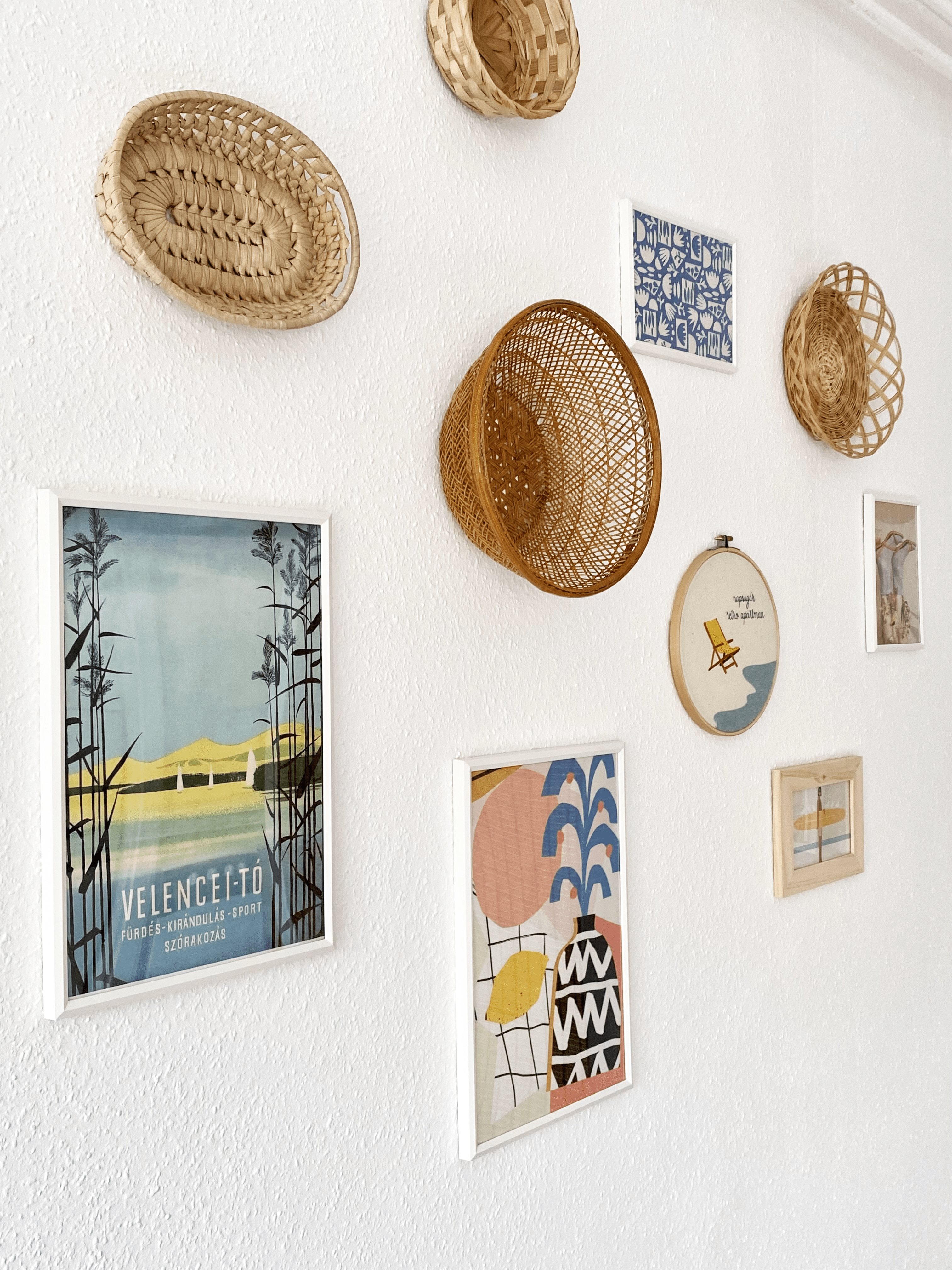Barbara Dénes, the founder of the Hungarian PLANTETHICS brand, and her husband, Dávid Menyhárt, have recently renovated one of Napsugár Holiday Cooperative’s cottages (Napsugár stands for Sunbeam) with their own hands: the two-story, top-floor apartment has everything you need for a peaceful family vacation. An impeccable retro holiday experience in Agárd. See for yourself!
Barbi, how did the story of the Napsugár Retro Apartman begin?
A few years ago, an opportunity showed up to buy holiday properties in Agárd, on the grounds of the former holiday cooperative: that was when we found this apartment of great potential, on the second floor of one of the buildings. This apartment was owned by a retired couple who renovated it according to their taste in the 80s and spent every summer there with their family. For a number of years after the purchase, one of our elderly family members has moved into the apartment. We loved to visit him there. He adored watching us play table tennis or badminton in the garden. We went swimming together, had barbecues, great chats, explored every corner of the friendly resort area, and I loved reliving my summer memories made at the Socialist Craft Union holiday homes.


This dear relative moved out this spring and we stood there among the worn-out, dark-brown window seals, and the fiberboard furniture and utensils from the 80s. We decided to finally turn it into a place where we would also enjoy spending our free time. We jumped on the train of nostalgia towards the countless pleasant childhood memories and the visuals of these old summers. We decided that this is the way to go! Let this be a retro apartment where the material culture and cheerful colors of the 60s-70s-80s can live in harmony with each other.
We wanted to link the works of contemporary Hungarian artists to all this, to show how much beauty and playfulness lies in the so-called mid-century modern style, how well the designs of the past and the present fit together if we clear up the foundations and let the objects live. We were strongly drawn to elements of the mid-century style such as the coherent, bright communal spaces, the large glass surfaces, the blurring of boundaries between outside and inside, and the central role of geometric shapes.


How did the work go? Did you renovate everything yourselves?
We started the renovations at the beginning of May: first, we had to decide what to keep, what to get rid of, and what could be modified to achieve the mood we wanted. Aside from a quick visit from an electrician, David undertook the electrical and plumbing work. We decided that we would do everything ourselves, and not wait months for the professionals.
I presented the idea to my friend Éva Szép, the designer of the Evuska brand—with whom we also collaborate in CikkCakk Studio, and co-create objects within PLANTETHICS as well—that the three of us should work on this together. We painted, glazed, scratched the tiles and joints, and the styling was taking shape as we went. We finished in a little over four weeks.


We wanted a center motif that—true to our name—evokes a sunny retro feeling, so I covered the dark brown kitchen furniture with bold yellow paint and I also made the accessories match this bright color. We kept the thirty-year-old Karancs gas stove in the kitchen but replaced the neon lights and the worktop. The dark brown plastic wall cabinet with its flickering neon lamps was removed from the bathroom and replaced with bright spotlights. A reed-framed mirror was placed here, as well as on the walls of the hall and the kitchen. We were lucky with the snow-white tiles: just like in the kitchen, we didn’t have to touch it here either.
On the stairs leading up and in the upstairs bedrooms we kept the fitted carpet and cleaned it thoroughly. We also kept the classic wood paneling in the attic. In the small bedroom, the sofa bed was inherited from the retired couple; the interior textile which is about the same age as us, is reminiscent of the reeds of Lake Velence with its patterns. While we discarded a lot of things from here, everything was kept in the large bedroom: the superb resort-style double bed, the single futon bed, the wardrobes.



What lends a retro atmosphere to the place? What treasures can we discover here?
When we were not working in Agárd or the capital, I kept scouting websites and markets offering retro home furniture and accessories. I met a lot of lovely people while hunting for the original, canary yellow table lamp made by the Szarvas Lamp Factory, the two wooden herons (one is from Retrohungary, the other one is from Múlt:kor – Otthon). I got the extendable, beech-wood dining table from the Cave Church of St. Gellért Square, which was used at artisan workshops in the past, thus it was covered in a thick layer of paint.

The elegant, beech-wood chairs in the dining room were scrapped by a downtown dentist, there are also beech-wood school chairs on the balcony, and the vintage IKEA sofa was obtained from a mom living in our neighborhood, an item that we barely managed to shove into our car before a heavy May storm hit us. I found the TV table four years ago at the Garmada flea market. It is in perfect condition, it even has the QC sticker on the bottom. It cost two thousand forints and ever since it was waiting in the attic to be put in the right place. Oddly, there used to be a washing machine in the living room and the kitchen had a small-sized fridge. The washing machine is now under the kitchen counter, and a retro-style, brand-new fridge-freezer has been added to the living room.


On one occasion, Éva even brought her sewing machine, and sewed the small curtains for the kitchen on the spot: I found a discontinued IKEA tablecloth, which we used as their fabric. The rest of the material didn’t go to waste either – it turned into beautiful pillowcases with ties for the small bedroom. It was extra cool from Éva that she screen printed her raccoon illustration only for us, and even painted Lake Velence on the canvas mural (which featured the Lake Balaton originally). We’re eternally grateful to her!


For the walls, I hand-picked old bread baskets from our attic and Cseriti, supplemented with retro illustrations and photos. Jute rugs decorated with pastel-colored wool yarns and knots also appear in the living room and in the large bedroom, and the canary yellow color of the kitchen lamp gets featured on pillows, blankets, bedspreads, and pictures as well. The kitchen cabinet hides retro glasses and a sunbeamed GRANIT bowl that also help evoke past summers.
Barbi, you are also a designer at a Hungarian brand, but still, we find much more than just Plantethics items in the apartment. What other Hungarian brands get represented here?
Next to the succulents, the shelves feature beautiful works by ceramicist Ágnes Csaba (CSAK) and creations from PLANTETHICS’ beautiful collections EARTH and REWOOD, while one of the pots was made by the girls at SUSU keramika. On the dining table, a bluish ceramic bowl by CSAK evokes the color of the lake, and the dried yarrow reminds us of the sunlight.


When things started to come together nicely, Evus Mezei, the creator of the EVUS brand, made our company sign embroidered in a wooden frame: a canary-yellow sunbed on the shores of Lake Velence beside an inscription in a handwritten style reminiscent of elementary school practice that says “napsugár retro apartment”. It was placed above the sofa in the living room, where the copy of a vintage poster promoting a Lake Velence holiday is also adorned.


For available dates and more information, visit the official website of the apartment. Don’t miss out!
Photos: Barbara Dénes

Luxury perfumery | TOP 5

Defining the atmosphere of a festival visually | Hype X WONDEREST










